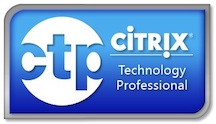This is part five of a series looking at XenApp 7.5.
Part one – What’s new, and installation
Part two – Configuring the first site
Part three – Preparing my XenApp template image
Part Four – Creating the machine catalog to give me a hosting platform
This part – Creating the delivery group to publish apps and desktops to user
In Part six I examine some new policy filtering options
In Part seven I examine some of the load balancing and fail-over changes
So we now have our hosting servers provisioned via our machine catalog. We now need to assign which applications get published to which users. Those familiar with the XenApp 6.x publishing wizard should find this step very straightforward, and the XenApp 7.5 version adds the ability to publish many applications simultaneously.

Since it’s formation in 2006, the Citrix Technology Professionals (CTP) program has steadily been growing in strength and popularity, but has recently reach a plateau in terms of membership and quality, with many claiming “it’s all gone a bit downhill since Brian left”
Commenting on the changes, Perrine “fine wine” Crampton, head of the Community Cat-herding Programs at Citrix:
“The CTPs have been running amok for way to long. Whilst we encourage CTPs to blog and tweet about their experiences with Citrix technologies, we’re seeing far to much negativity and brutally honest criticism about Citrix’ poor code quality and bad marketing decisions. As Citrix Marketing fund the CTP program in it’s entirety, it’s their way or the highway I’m afraid, and it’s this new mantra which forms the basis of the changes we’re announcing today.
- From now on, new and existing CTP’s will need to follow our CMO‘s lead, and delete their twitter accounts and reduce their Facebook usage to only posting inspirational photos, memes and pictures of their kids/cats.
- Early access to code releases will cease to avoid the flood of bug reports that traditionally happen around the time of new product releases that just distract the engineers and developers from Flappy Birds and the code shipping parties.
- Participation at company events such as GeekSpeak and Citrix Synergy will only be possible having signed an NDA prior to the event, and agreeing not to actually speak to anyone important or impressionable (especially customers) for the duration of the conference.
- The bi-annual CTP meetings where members get the opportunity to grill product managers on their plans for the forthcoming roadmap’s will be replaced by an on-line voting system where CTPs can vote on their top feature they would like to see implemented (bearing in mind that many product teams can only deliver one feature in each release)
- The current selection process based on community contribution is flawed. It gives a platform to people far too opinionated and influential which could result in Citrix being seen in a poor light. New criteria already in place ensures all those selected will look great on Citrix.tv when interviewed, and carry around at least four devices capable of running Receiver at all times, just in case they get stopped in the street and challenged on their allegiance to Citrix.
- The CTP program will take on a new corporate sponsor: Atlantis Computing. Becoming a CTP will now mean automatic enrolment onto the Atlantis payroll.
Those interested in applying to the CTP program may apply themselves or pay someone influential to nominate them. The number of existing CTPs you “have in the bag” will have no influence on your chances of being accepted into the program.
In other news, the CTO Office have announce the replacement of Brad Anderson as Chief Demo Officer having realised they have a far better qualified person who’s been quietly hiding amongst their board of directors for the past decade and now needs to realise the investment they’ve made in him.
Part one – What’s new, and installation
Part two – Configuring the first site
Part three – Preparing my XenApp template image
This part- Creating the machine catalog to give me a hosting platform
Part five – Creating the delivery group to publish apps and desktops to user
In Part six I examine some new policy filtering options
In Part seven I examine some of the load balancing and fail-over changes
Now that we have a master image prepared containing the VDA and our applications, we can now use this as the basis for our first machine catalog to give us a hosting platform to start delivering applications (and server-hosted desktops) to users
In part one of this blog series I examined the new features in XenApp 7.5, and the installation process.
In part two I setup the hypervisor connection and created the first site in the Studio console
In this part will create our XenApp image that MCS will then use to create our hosting platform for users and applications.
In part four I create a machine catalog to provide some XenApp hosting servers ready to publish my applications from
In part five I create the delivery group to publish applications and desktops to my users
In Part six I examine some new policy filtering options
In Part seven I examine some of the load balancing and fail-over changes
In part one of this blog series I examined the new features in XenApp 7.5, and the installation process.
In this part I’ll now continue and create our first XenApp site.
In part three I cover creating my master template image
In part four I create a machine catalog to provide some XenApp hosting servers ready to publish my applications from
In part five I create the delivery group to publish applications and dekstops to end user
In Part six I examine the new policy filtering options
In Part seven I examine some of the Load balancing and fail-over changes
As with all images on this blog, click on the screenshots to enlarge them

